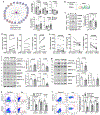Fasting-induced FOXO4 blunts human CD4+ T helper cell responsiveness
- PMID: 33723462
- PMCID: PMC7990708
- DOI: 10.1038/s42255-021-00356-0
Fasting-induced FOXO4 blunts human CD4+ T helper cell responsiveness
Abstract
Intermittent fasting blunts inflammation in asthma1 and rheumatoid arthritis2, suggesting that fasting may be exploited as an immune-modulatory intervention. However, the mechanisms underpinning the anti-inflammatory effects of fasting are poorly characterized3-5. Here, we show that fasting in humans is sufficient to blunt CD4+ T helper cell responsiveness. RNA sequencing and flow cytometry immunophenotyping of peripheral blood mononuclear cells from volunteers subjected to overnight or 24-h fasting and 3 h of refeeding suggest that fasting blunts CD4+ T helper cell activation and differentiation. Transcriptomic analysis reveals that longer fasting has a more robust effect on CD4+ T-cell biology. Through bioinformatics analyses, we identify the transcription factor FOXO4 and its canonical target FK506-binding protein 5 (FKBP5) as a potential fasting-responsive regulatory axis. Genetic gain- or loss-of-function of FOXO4 and FKBP5 is sufficient to modulate TH1 and TH17 cytokine production. Moreover, we find that fasting-induced or genetic overexpression of FOXO4 and FKBP5 is sufficient to downregulate mammalian target of rapamycin complex 1 signalling and suppress signal transducer and activator of transcription 1/3 activation. Our results identify FOXO4-FKBP5 as a new fasting-induced, signal transducer and activator of transcription-mediated regulatory pathway to blunt human CD4+ T helper cell responsiveness.
Trial registration: ClinicalTrials.gov NCT02719899 NCT01143454 NCT00001846.
Conflict of interest statement
Competing interests: None
Figures









References
-
- Fraser DA et al. Reduction in serum leptin and IGF-1 but preserved T-lymphocyte numbers and activation after a ketogenic diet in rheumatoid arthritis patients. Clin Exp Rheumatol 18, 209–214 (2000). - PubMed
Publication types
MeSH terms
Substances
Associated data
Grants and funding
LinkOut - more resources
Full Text Sources
Other Literature Sources
Medical
Molecular Biology Databases
Research Materials
Miscellaneous

